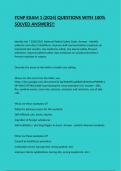FCNP EXAM 1 (2024) QUESTIONS WITH 100%
SOLVED ANSWERS!!
Identify the 7 2020/2021 National Patient Safety Goals Answer - Identify
patients correctly (2 identifiers), Improve staff communication (emphasis on
important test results), Use medicines safely, Use alarms safely, Prevent
infections, Improve patient safety risks (emphasis on suicide prevention),
Prevent mistakes in surgery
Describe the areas of risk within a health care setting
(these are the ones from the slides, see
https://docs.google.com/document/d/1pCSX6s891yqh8dA1R4mOzszPWWBv1
DP-9WcCVTEYKoU/edit?usp=sharing for more extensive list) Answer - falls,
fire, sentinal events, near miss, seizures, seclusion and restraints, use of side
rails
What are these examples of?
Patient is primary reason for the accident:
Self-inflicted cuts, burns, injuries
Ingestion of foreign substances
Self-mutilation / pinching fingers in doors Answer - patient inherent accidents
What are these examples of?
Caused by healthcare providers:
medication errors (wrong med, wrong patient, etc)
improper device applications (wrong site, wrong equipment, etc.)
,improper performance of procedure (wrong surgical site, left object inside
patient, etc.) Answer - procedure related accidents
What are these examples of?
Caused by equipment issues:
malfunction
disrepair
electrical hazards Answer - equipment related accident
Why do a patient's economic resources affect their safety? Answer - low
income leads to worse health outcomes and less safe environments
Describe assessment activities to identify physical, psycho-social and cognitive
changes that may affect patient safety Answer - observe patient (for posture,
range of motion, gait, strength, balance, and body alignment), assess patient's
visual acuity, developmental level, economic resources, mobility, sensory,
cognitive status, lifestyle choices, environmental hazards
Assessment of these factors would be considered a ______ _______
__________
Patient's own perception of risk factors
Patient's concern over being in a healthcare setting
Patient knowledge on how to adapt to safety risk
Information about a patient's previous experiences with accidents Answer -
patient centered assessment
Assessment of these factors would be considered an assessment of
__________ ____________
Hazards in the environment: obstructions, items inaccessible, lack of proper
,Risk for falls: meds, mobility, cognition, habits, family education
Risk for medical errors: faculty alertness, stress/reflection of procedures
Disasters: lighting, safety devices in place, furniture, walk space, supplies
Locks, chemical exposures of cleaners, functioning utilities Answer - healthcare
environment
What types of lifestyle choices affect a patient's safety? Answer - dangerous
jobs, substance use/abuse, medications, stress, activity, exercise
Home maintenance and safety are examples of _____________ _______ that
affect a patient's safety Answer - environmental hazards
What does impaired mobility put a patient more at risk for? Answer - falls and
injury
_________ __________ associated with dementia or mental illness increases
risk for accidents. Answer - cognitive impairment
Reduced health literacy or lack of safety awareness increases risk for accidents.
True or False? Answer - true
Define:
Used only when clinically justified or when warranted by patient behavior
Used only when ordered by a physician or other authorized independent
practitioner
Condition of the patient who is restrained or secluded must be monitored,
evaluated, re-evaluated, and findings documented (every 2 hours)
The facility must have written policies and procedures governing restraints and
seclusion Answer - standards on restraints and seclusion
, What is the 2-finger rule regarding restraints used for? Answer - assess skin
breakdown and circulation
Which of these should you NOT do when a person is having a grand mal type
seizure?
A. Hold the person down or try to control activity
B. Turn the person on their side
C. Clear the area of sharp or hard objects
D. Offer water or food until fully alert
E. Loosen anything around the neck
F. Give mouth to mouth resuscitation
G. Time the seizure
H. Ease the person to the floor
I. Place anything in their mouth
J. Remove eyeglasses
K. Protect the head Answer - A, D, F, I
What are the 6 parts of the chain of infection? Answer - infectious agent
(pathogen), reservoir, portal of exit, mode of transmission, portal of entry,
susceptible host
These pathogens are examples of _________ ________
Salmonella
Tuberculosis
Legionella
Cholera




